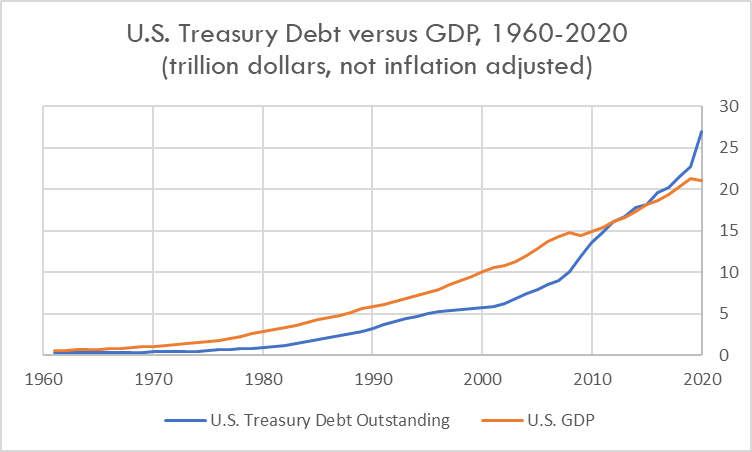

By Robert Mulligan
Closed societies can always become wealthier by trading. Perhaps the most dramatic illustration of growth through trade was realized by Japan after the Meiji restoration in 1868, ending the Tokugawa Shogunate founded in 1603. For over 250 years the Shogunate enforced a policy of economic isolation. Japan’s subsequent openness to international trade enabled it to recover from World War Two and become one of the world’s most affluent nations on earth in less than a generation.
Every country can benefit by reducing import tariffs to zero, making international trade even cheaper, but many have opted for tariffs and other trade restrictions to protect domestic industries and employment. World trade grew dramatically over the 20th century, especially since the end of World War Two. This would be true anyway, because world GDP grew over the same period, but world trade also increased dramatically as a percentage of world GDP.
At the end of World War Two, recognizing the detrimental impact of high tariffs enacted during the Depression, the victorious allies met at Bretton Woods, New Hampshire and negotiated the three Bretton Woods organizations. These were the International Monetary Fund (IMF), the International Bank for Reconstruction and Development (IBRD), better known as the World Bank, and a proposed International Trade Organization (ITO). The ITO was never organized because the US Senate would not ratify the enabling treaty, though the US did support and participate in the General Agreement on Trade and Tariffs (GATT).
By informal agreement, the World Bank president has almost always been an American, and the IMF managing director must be from another country, though both organizations are headquartered in Washington. The World Bank was initially charged with administering a revolving loan fund to facilitate the reconstruction of war-torn Europe and Asia. Once that task was accomplished, the World Bank turned its attention to the developing world, though in practice this was supplemented by Marshall Plan loans directly from the US.
The IMF was initially charged with administering a fixed exchange rate system where each national currency was convertible to US dollars, and the dollar was fixed to gold at $35 per ounce—a significant drop from the pre-Depression value of $20. This fixed exchange rate system collapsed between 1971 and 1973, and since intergovernmental bureaucracies naturally seek immortality, the IMF reinvented itself as a development lender competing with the World Bank, as well as with a number of regional development banks implemented over the years, such as the Inter-American Development Bank (IDB) founded in 1959 in Washington, the Asian Development Bank (ABD) founded in Manila in 1966, and the European Bank for Reconstruction and Development (EBRD) in London, organized in 1991 in the wake of the collapse of the Soviet Union.
The ITO was never organized because US participation was necessary. This was withheld because the Senate declined to ratify the necessary treaty. Nevertheless, the US participated in the General Agreement on Trade and Tariffs (GATT), which took effect in 1948. GATT signatories committed to continuous tariff reduction. By the eighties, tariffs had fallen to negligible levels on many goods. GATT was replaced by the World Trade Organization (WTO) in 1995, though the 1947 GATT treaty remains one of the WTO’s enabling documents. The growth of world trade has helped increase national GDPs and contributed to each nation’s productivity, as it’s cheaper for trading nations to import everything that would cost them more to produce at home. It also makes a wider range of goods and services available and enables trading countries to specialize in those products they have a comparative advantage in producing.
In addition to its general commitment to continuous tariff reduction, the WTO provides a mechanism for adjudicating trade disputes among nations. However, when the WTO finds merit in one country’s complaint, the most it can do is permit the complainant to impose a retaliatory tariff. This kind of enforcement mechanism tends to favor large countries over small ones, for whom a retaliatory tariff can be devastating. Countries have also negotiated tariff reductions through trade agreements like the North American Free Trade Agreement (NAFTA), the United States-Mexico-Canada Agreement (USMCA), the European Union (EU), and the Trans-Pacific Partnership (TPP), though in most cases these highly-touted free trade arrangements provide whole rafts of exemptions to favor privileged firms and industries. In some cases they effectively circumvent the WTO’s low-tariff regulations.
Traditionally, international trade was understood largely in terms of agricultural specialization. Labor and capital were taken for granted, but it was recognized that countries with more temperate climates and good soil had an advantage in growing pretty much everything. For example, France has an absolute advantage over England in growing both wheat and grapes, but this absolute advantage is stronger in grapes than in wheat. That made it advantageous for the French to import wheat from England, which they paid for by exporting wine.
Having the English grow wheat for export to France freed up more land in France for grape cultivation, resulting in both countries’ being able to consume more bread and more wine than either could produce separately without trade. Though France has an absolute advantage in producing both products, the direction of trade follows comparative advantage. France has a comparative advantage in producing wine, both compared with its ability to grow wheat, as well as compared with England’s ability to produce wine. England has an absolute disadvantage compared to France in growing both crops, but still enjoys a comparative advantage in wheat, both compared to France and compared to growing grapes in England.
As Adam Smith observed, international trade expands the extent of the market, enabling more people to participate, and providing more opportunities for specialization and gains from trade. Today it’s quite common for Americans to buy manufactured goods that were made as far away as China. Some other trends that have occurred over the same period are an increase in manufactured goods being traded internationally, compared with agricultural output, even though the total physical amount of agricultural goods being traded is much greater today than in the past, and the growth of trade in services.
Throughout much of the 1800s, America exported agricultural crops and raw materials, and imported manufactured goods from more industrialized Europe. After World War Two, the US was a net exporter until about 1970, but since then we have run a persistent trade deficit. When we import goods from China, we pay in US dollars. There is still some demand for foreigners to hold dollars due to its role as a reserve currency, an artifact of the 1945-1973 Bretton Woods system administered by the IMF. Perhaps more important is the fact that historically, whenever US inflation gets out of control, it has generally been worse elsewhere. Eventually the dollars have to come back to the US to buy US-produced goods or some other dollar-denominated assets. The government has played a major role in exploding the US trade deficit because it habitually spends beyond its means, under both parties.
Figure 1


Treasury debt created to finance the shortfall between tax revenues and government spending increasingly keeps the dollars we spend on imported products coming back to finance our exports. Instead of exporting manufactured output that employs Americans, we’re effectively exporting US Treasury bonds. For the last quarter of the 1900s, Japanese savers were the largest holders of US Treasury debt. From their perspective, it was safer and higher-returning than any other investment. This became less true as the Japanese government followed in our footsteps and ran up significant debt of its own starting about 1990, and the US government lowered interest rates to stimulate the economy in response to the 2007-2009 recession. In the 2000s Chinese state-owned enterprises became the largest holder of US Treasury debt, displacing the Japanese. Increasingly profligate government spending has driven the federal debt higher than annual GDP, with no end in sight (Figure 1). What are we getting for this unprecedented debt? Mostly, all it’s purchased for us is political leadership which can only charitably be characterized as mediocre.




